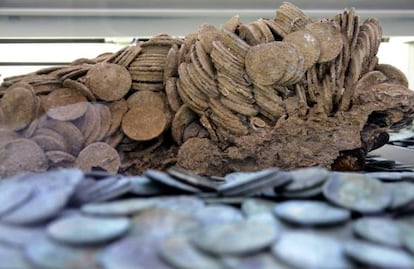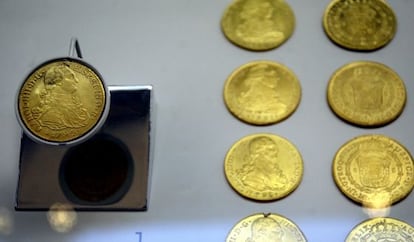Spain’s hard-won shipwreck coins finally go on public display in Cartagena
Exhibition of half-a-billion-dollar hoard taken from frigate Nuestra Señora de las Mercedes opens Spanish government took trove back from US treasure hunter Odyssey after a long legal battle

Five years after being scooped up from the seabed off the coast of Cadiz by US deep-sea treasure-hunting company Odyssey, and following lengthy legal wrangling over their ownership, around 8,000 coins from a much larger haul that was aboard a Spanish frigate sunk by the British in 1804 have gone on display at ARQUA, the National Sub-Aquatic Archeology Museum, in Cartagena.
The Spanish government sees its success in reclaiming the coins as a major victory against companies such as Odyssey, which scour the world’s oceans in search of sunken booty. The case sets a legal precedent, providing Spain with the mechanisms and procedures to protect hundreds of its vessels lying on the seabed around the world sunk in centuries past.
“This is an unprecedented international triumph against plundering and the illegal traffic in cultural heritage,” José María Lassalle, Spain’s secretary of state for culture, told assembled dignitaries on May 29 at the opening of a permanent exhibition about the vessel, Nuestra Señora de las Mercedes, which will focus on Spain’s fight to recover almost 600,000 coins worth an estimated half-a-billion dollars that Odyssey found aboard.
Iván Negueruela, ARQUA’s director, gave journalists a guided tour of the exhibition, which aside from explaining the historical background to the treasure haul, also highlights what he calls the dangers of underwater “piracy.”
The exhibition is divided into four parts: “New Routes and Inter-Oceanic Trade”; “Naval Construction”; “Nuestra Señora de las Mercedes”; and “A Legacy to be Protected?”.

The first part of the exhibition includes a large interactive globe that outlines the trade routes between Spain and Portugal and their respective empires in the Americas, Africa and the Philippines that were established in the 16th century, and were in decline by the beginning of the 19th century, when the region began fighting for independence, and Spain had been invaded by Napoleon. A full-scale cross-sectional model of part of the Nuestra Señora de las Mercedes’ hold has been constructed containing barrels and chests of spices and tobacco.
The centerpiece of the exhibition is two glass cases, one containing around 8,000 restored coins from the original haul of 580,000: a further 35,000 have been cleaned and will form part of an exhibition that will tour Spain. The second case holds 500 more coins, alongside other personal objects found aboard the wreck.
The final part of the exhibition explains the importance of protecting deep-sea wrecks from companies such Odyssey, arguing that they provide an invaluable research resource for historians and researchers.
Spain has also taken the first step toward compiling an inventory of its sunken vessels scattered across the bottom of the world’s oceans. A new map, prepared by underwater archeology specialists Nerea Arqueología Subacuática (NAS) on behalf of the Culture Ministry, locates ships lost when Spain was still a major naval power, and is a key move by the Spanish government to protect this part of the country’s heritage from treasure hunters.
The map is far from complete. Much of the ocean is still inaccessible, and thousands of other wrecks lie undiscovered, many likely to contain valuable cargos of gold and silver, while others could offer vital historical information.
Spanish law forbids trading in anything that is part of the country’s heritage. This raises the question of whether private companies should be involved in searching for sunken vessels, in return for a part of any treasure found.

In May 2007, treasure hunters from US company Odyssey Marine Exploration set out for European waters hoping to find buried riches. At the bottom of Spain’s Atlantic coast, near the Strait of Gibraltar, they discovered Nuestra Senora de las Mercedes, which had been sunk in an 1804 naval battle with the British, taking with her 200 passengers and a vast hoard of silver coins.
Despite an international ban, the company took a chance and hauled their big win – a treasure trove weighing 17 tons – back to the United States. But when it showed some of the coins to the media, the Spanish government immediately recognized them, and matching them to the archive of sunken vessels, soon traced their origin to the Nuestra Señora de las Mercedes.
The Spanish government brought legal action in the US courts against Odyssey to get the coins back. Finally, in February 2012, a Miami court ordered their return.
If Odyssey wants to continue exploring for sunken vessels, it now has little option but to hire its services out to governments interested in recovering the contents of shipwrecks. The legal wrangle has robbed the company of any credibility among marine archeologists, who are deeply suspicious of its for-profit motive. The company’s other option is to use its highly sophisticated underwater technology to extract minerals and precious stones from the seabed.
Tu suscripción se está usando en otro dispositivo
¿Quieres añadir otro usuario a tu suscripción?
Si continúas leyendo en este dispositivo, no se podrá leer en el otro.
FlechaTu suscripción se está usando en otro dispositivo y solo puedes acceder a EL PAÍS desde un dispositivo a la vez.
Si quieres compartir tu cuenta, cambia tu suscripción a la modalidad Premium, así podrás añadir otro usuario. Cada uno accederá con su propia cuenta de email, lo que os permitirá personalizar vuestra experiencia en EL PAÍS.
¿Tienes una suscripción de empresa? Accede aquí para contratar más cuentas.
En el caso de no saber quién está usando tu cuenta, te recomendamos cambiar tu contraseña aquí.
Si decides continuar compartiendo tu cuenta, este mensaje se mostrará en tu dispositivo y en el de la otra persona que está usando tu cuenta de forma indefinida, afectando a tu experiencia de lectura. Puedes consultar aquí los términos y condiciones de la suscripción digital.
Últimas noticias
From digital curfews to blocking apps: How technology experts protect their children online
Why the price of coffee has skyrocketed: from Brazilian plantations to specialty coffee houses
Confined to a Cuban hospital: When electricity is a matter of life or death
The complicated life of Francesca Albanese: A rising figure in Italy but barred from every bank by Trump’s sanctions
Most viewed
- Why we lost the habit of sleeping in two segments and how that changed our sense of time
- Pablo Escobar’s hippos: A serious environmental problem, 40 years on
- Trump’s obsession with putting his name on everything is unprecedented in the United States
- The Florida Keys tourist paradise is besieged by immigration agents: ‘We’ve never seen anything like this’
- Charles Dubouloz, mountaineering star, retires at 36 with a farewell tour inspired by Walter Bonatti








































